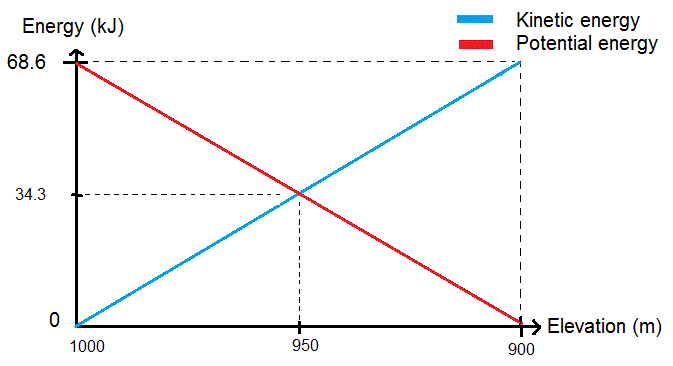Real life example
Example of energy transformationNon ideal condition
In real life, the
energy is not conserved. Energy loss occur because of
friction between skis and snow. To prevent that, skiers
wax their ski chambers with paraffin waxes, which repel
water molecules in snow and reduce then the friction
coefficient. Another way how to get closer to ideal
skier, is aerodynamic spandes which helps improve the
air flow due lower air resistance. Skier uses various
for minimalizing the energy loses, skier wax their skis
and wear slim spandex, so their skis have smaller
friction during the contact with snow and their spandex
makes them more aerodynamic.
Ideal condition example
In real world, we deal with lots of
variables in downhill skiing. For our example purpose,
we will neglect air resistance and friction between skis
and snow. This brings us to ideal problem, when energy
in system is conserved between potential and kinetic
energy, Ep and Ek respectively
Equation for energy transformation:
Ep(initial) + Ek(initial)
= Ep(final) + Ek(final)
Equation for gravitational potential
energy:
Ep = mass * g * height
Equation for gravitational kinetic
energy:
Ek = 0.5 * mass * (speed)^2

Example
Skier with weight 70kg skis down the ski slope, which start gate altitude is 1000 m above the sea level and altitude at the bottom of the hill (in finish) is 900 m above the sea level.
A) How does skier potential energy transform into kinetic energy during downhill ride?
B) What will his speed be when he crosses the finish line?
m = 70 kg
Altitude at the top of the hill = 1000 m above the sea.
Altitude at the bottom of the hill = 900 m above the sea
level.
We consider no air resistance and frictionless contact
between skis and snow.
Solution:
A)
Ep(initial) + Ek(initial) =
Ep(final) + Ek(final)
Ek(initial) = 0
Ep(final) =
0
=>
Ep(initial) = Ke(final)
Ep(initial) = mass * g * height = 70 kg * 9.8 m/s2 *
(1000-900m) = 68,600 J
Ek(final) = 68,600 J = 68.6 KJ
B)
Ek(final) = 0.5 * mass * (speed)^2 =>
velocity = (2*Ek/mass )^0.5 = (2*68,600 J /70
kg)^0.5 = 44.3 m/s
To imagine the speed better, we can convert it to
miles per hour.
v(MPH) = (44.3 m/s)*(1mile/1609m)*(3600s/hr) = 99.1
MPH
There is graph, below, showing change in energies
(assuming constant slope)

Graph made by Jan Cech
Conclusion
To be honest our example was ideal, in real world, skiers reach similar speed, but they need higher hills to reach the speed. Also in real world, the horizontal distance plays its roles as well and the energy is not conserve, while the speed not only depends on the elevation of race course, but also the horizontal distance. Shorter and steeper hills give skiers higher velocity, because the friction (due to normal force) is smaller, than for more flat course with same elevation. Also in real world the friction coefficient increases with duration of race, because the waxed layer on skis is getting thinner. We also assumed that skier did not turn the whole time, so he did not lose any kinetic energy for turns.
Support for my ideas comes from
http://www.physicsclassroom.com/class/newtlaws/Lesson-2/Types-of-Forces
 Jan Cech
Jan Cech